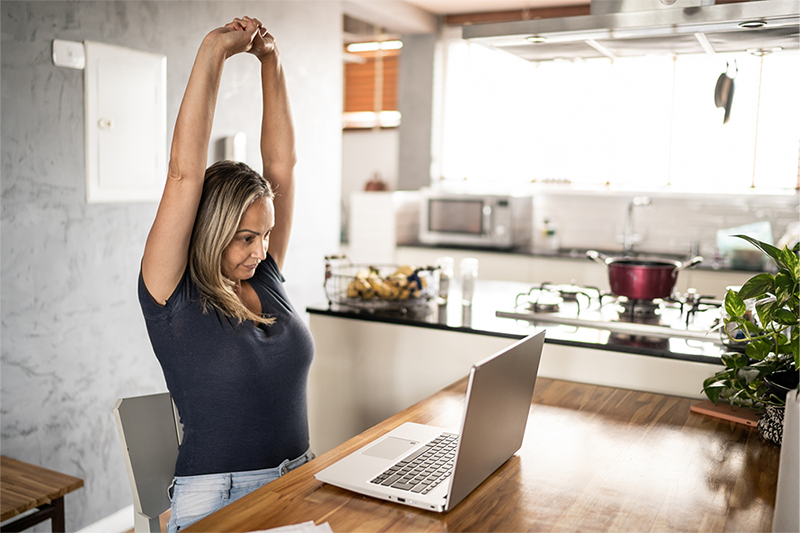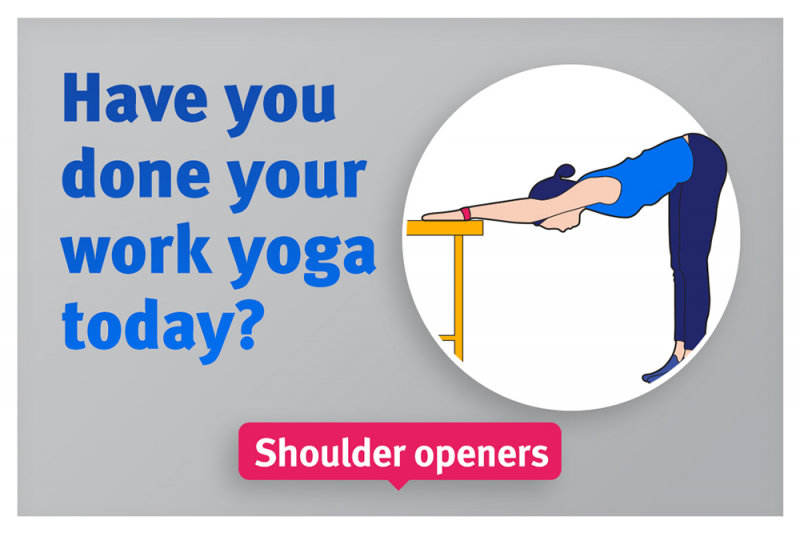
A man sitting behind an office desk and computer screen does yoga neck stretches
Making sure your work setup is ergonomic is a no-brainer, but even with the perfect desk setup our bodies aren’t designed to stay in one spot all day.
Whether you’re a standing desk person or a sitter, incorporating some yoga into your day will leave your body and mind feeling totally Zen.
The benefits of yoga can be amazing, both for your physical and mental wellbeing. These include increased fitness and flexibility, possible reduction in high blood pressure, as well as reducing and managing stress.
If you’ve never experienced yoga before, at its heart it is the connection of movement to breath. Yoga is the practice of combining physical poses with controlled breathing and often includes meditation.
There are many different yoga practices, and each comes with a different level of intensity.
While we’d recommend finding a qualified yoga teacher if you’d like to try a regular and perhaps more strenuous practice, tapping into the health benefits of yoga doesn’t mean that you need to be able to do a perfect handstand.
In fact, there are plenty of yogi things you can do outside of a yoga studio and even without getting up from your desk (although you should be doing that regularly too).
Let’s go from the top down.
Yoga, but for your brain
Legit yogis will tell you that there’s more to yoga than downward dog. In fact, yoga is mindfulness; one does not exist without the other. A modern-day yoga class is a series of movements linked to breath, but you can practice yoga without the movement.
The benefits of mindfulness on your overall wellbeing are well documented, and you can find lots of information and resources on our Dear Mind website
Mindfulness is the practice of directing your attention to what is happening in the present moment around you.
There are many ways you can practice mindfulness at your desk, but here are a few:
- Observe your breathing: Take ten deep breaths: in through your nose and out through your mouth. As you go, gradually lengthen your inhales and exhales, aiming for four seconds each. You can do this with your eyes shut, but if that’s not possible (like if you’re in a meeting) it’s just as effective with them open. Slowing down your breathing soothes the nervous system and tells your body that it’s safe to relax. It’s the ultimate stress reliever.
- Ground down: Plant your feet firmly on the ground under your desk, spread out your toes and press firmly down through the soles of your feet. Becoming aware of the floor beneath you automatically brings you back to the present moment.
- Take a moment to meditate: There are plenty of mindfulness apps that offer five- minute or less meditations. Grab your headphones and run one of those.
Yoga originated in India between 400-100 BCE, and the physical movement or ‘asanas’ were designed to optimize the body for yogis to be able to sit still and meditate for hours at a time.
Here are some simple, yogic movements that you can do at your desk.

Give your neck a break, it carries a lot
That is, your whole head! Here are a few easy moves that’ll release tension:
Head nods
- Place your feet firmly on the ground with your hands in your lap. Ensure your spine is long and straight.
- Inhale through your nose and as you exhale, nod your head forward for a count of three.
- Then lean your head backwards (keeping your spine upright), opening up your chin towards the ceiling.
- Repeat this three times.
Ear to shoulder stretch
- Again, make sure your feet are flat on the ground and your hands are comfortably in your lap.
- Roll your shoulders back and down and then keep them still.
- Inhale, and lean your head to the left, keeping your shoulder completely still. It’s as if you want your ear to meet your shoulder. You should feel a juicy stretch along the side of your neck.
- Repeat on the other side. You can do this as many times as feels good.
Twist again
While it’s important for our posture to sit or stand upright while we work, our spines like to move in all directions. Here’s a stretch you can do seated at your desk that makes space for your spine:
You can do this one seated, with your feet firmly on the ground facing forwards.
- Raise your arms up above your head and turn your torso to your right, at the same time bringing your left hand to your outer right thigh, and your right hand behind your back.
- You will feel how far you want to take this stretch, but as you twist ensure that you continue you lengthen your spine up from the crown of your head. Imagine someone has a length of thread pulling your head towards the ceiling.
- Raise your arms
Wring out your wrists
It’s easy to forget how much work our hands do for us—typing, carrying, cleaning—and how easily we can overwork them. Our wrists like a good stretch as much as the next joint, so here’s a few ways that you can give them some release.
This one utilizes your desk, and you will need to do it standing up.
- Turn your fingers towards you, so your wrist faces forwards and place your palm down on the desk.
- You will feel the stretch in your wrist immediately and how much more stretch you would like is your journey, but you can move your weight forward and back to get in all the sticky parts of your wrist.
- Repeat on the other side.
Jazz hands
This next one might get some weird looks from your colleagues, but the benefits are worth it. It’s a great way to activate all the muscles in your hands and wrists and move them in a different way to what they are used to (e.g. typing!).
- Raise your hand next to your head so that your elbow is at a right angle.
- With your palm facing forward, make a fist and then release. Repeat this action, as fast as you can for thirty to sixty seconds. It is meant to burn, that means it’s working.
- Repeat with the other hand. If you’re game, do both hands at once.

Desk downward dog
You can see a few of the poses we’ve discussed in the video below, but at the 28 second mark you can see how easy it is to get the benefits of a downward dog without the need for yoga pants (in fact, you can do it in a dress).
- Place your hands flat on the desk and push your chair back so you are arm’s length from the desk.
- With your feet flat on the floor, place your head between your arms.
- Press your hands down firmly on the desk and roll your shoulders away from your ears.
- Hold for ten seconds. Repeat as much as feels nice.
Open hips
Sitting all day means are hips are in the same, closed position which can leave the muscles in our hips feeling tight. In this video, there’s a simple hip opening exercise that you can easily do at your desk (along with a few other handy desk yoga moves).
- Place your right ankle on your left knee.
- Gently push your right knee down towards the ground – not too much, just until you feel a stretch.
- Hold for ten seconds.
- Repeat on the other side.
We hope that this simple guide to incorporating some more movement into your everyday office life is useful. Perhaps it’s a jumping off point for your yoga journey – if that’s the case, there are plenty of resources online if you’d like to deepen your yoga practice, or perhaps try a class in real life. Always make sure to listen to your body – if something doesn’t feel right, then stop doing it.
Here's to a healthier and happier you at work!